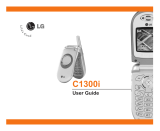
Please read these simple guidelines. Not
following these guidelines may be dangerous
or illegal. Further detailed information is given
in this manual.
Exposure to radio
frequency energy
Radio wave exposure and Specific
Absorption Rate (SAR) information
This mobile phone model KG800 has been
designed to comply with applicable safety
requirement for exposure to radio waves.
This requirement is based on scientific
guidelines that include safety margins
designed to assure this safety of all persons,
regardless of age and health.
]
The radio wave exposure guidelines
employ a unit of measurement known as
the Specific Absorption Rate, or SAR.
Tests for SAR are conducted using
standardized method with the phone
transmitting at its highest certified power
level in all used frequency bands.
]
While there may be differences between
the SAR levels of various LG phone models,
they are all designed to meet the relevant
guidelines for exposure to radio waves.
]
The SAR limit recommended by the
international Commission on Non-Ionizing
Radiation Protection (ICNIRP), which is
2W/kg averaged over ten (10) gram of
tissue.
]
The highest SAR value for this model
phone tested by DASY4 for use at the ear
is 0.596 W/kg (10g).
]
SAR data information for residents in
countries/regions that have adopted the
SAR limit recommended by the Institute of
Electrical and Electronics Engineers (IEEE),
which is 1.6 W/kg averaged over one (1)
gram of tissue.
Before a phone model is available for sale to
the public, it must be tested and certified to
the FCC that it does not exceed the limit
established by the government-adopted
requirement for safe exposure. The tests are
performed in positions and locations (e.g., at
the ear and worn on the body) as required by
Guidelines for safe and efficient use
Guidelines for safe and efficient use
9




















